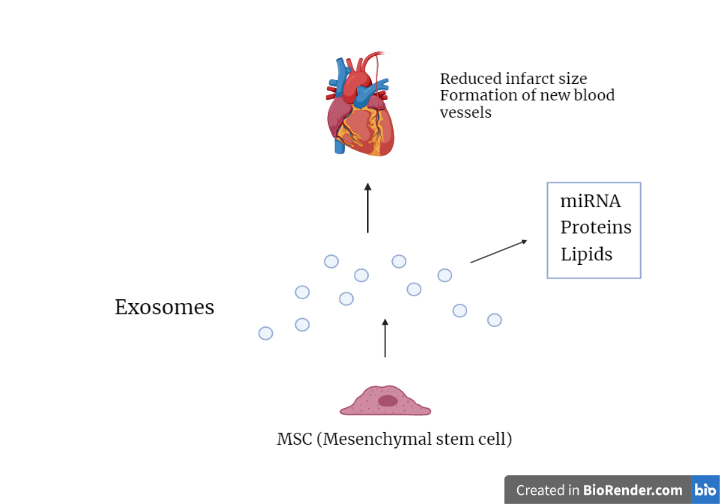Role of MSC-derived Exosomes in the Treatment of Cardiovascular Diseases
SUHANI SALE
D.Y. PATIL SCHOOL OF BIOTECHNOLOGY AND BIOINFORMATICS
suhanisale23@gmail.com
Cardiovascular diseases (CVDs) are the leading cause of death worldwide; accounting for an estimated 17.9 million lives every year and represents 32% of global deaths. CVDs are a group of disorders of the heart and blood vessels which include coronary heart disease, cerebrovascular disease, rheumatic heart disease, and other conditions. Approximately 85% of CVD deaths are due to heart attacks and strokes, and one-third of these deaths occur in people under the age of 70.
Stem cell therapy
Recent advances in stem cell therapy, especially using Mesenchymal stem cells (MSCs), have paved the way for innovative therapeutic techniques for several cardiovascular diseases. Mesenchymal stem cells are multipotent stem cells, which means that they can produce more than one type of specialized cell of the body. They are found in many adult tissues, such as bone marrow adipose tissue, and have the potential to differentiate into a great array of cell types in the adult body, such as skeletal tissues, heart cells, nerve, and liver cells, and many more. Their therapeutic efficacy is due to the secretion of paracrine factors, which inhibits the death of cells affected with injury, and has anti-inflammatory and immunomodulatory properties. However, since the research is still in its infancy stage, questions about how the cells can be controlled, their behavior when transplanted into the body, accurate delivery to the right place so that they work effectively, are yet to be elucidated, thus limiting their use for novel therapeutics.
Characteristics of MSC-derived Extracellular vesicles (EVs)
In an effort to improve therapeutics, many alternative experimental studies have shown that the extracellular vesicles (EVs), which are cell derivatives present in stem cells, contain diverse cellular molecules, have been used for regenerative therapy. In this context, EVs derived from MSCs may be used as model instruments in developing, diagnosing, and treating various cardiovascular diseases and serve as an alternative for using stem cells as a whole. EVs derived from MSCs contain a wide range of lipids, proteins, and RNAs. In the process of cardiovascular disease and repair, the composition and internal constituents of EVs are responsible for cell-to-cell communication which is a major factor in paracrine effects. From a cell therapy viewpoint, secretions from these constituents stimulate myocardial regeneration and cardioprotective effects and could, in principle provide a molecular basis for the treatment of a diverse range of diseases (e.g., acute myocardial infarction, end-stage ischemic heart disease, or prevention of vascular restenosis), osteogenesis imperfecta (OI) or brittle bone disease amyotrophic lateral sclerosis (ALS), lysosomal storage diseases (e.g., Hurler syndrome), steroid-refractory graft versus host disease (GVHD), periodontitis and bone fractures (Lai RC, et al, 2012).

Figure for therapeutic effect of MSC-derived exosomes for cardiovascular diseases through various constituents like miRNA, Protein, Lipid.
Therapeutic effects of MSC-derived Exosomes
A most commonly used therapeutic constituent of this secretion are exosomes, a secreted bilipid membrane vesicles of ∼50–100 nm with a complex cargo that is internalized, possibly by endocytosis, by affected cardiomyocytes is shown to reduce infarct size in a mouse model of myocardial ischemia/reperfusion (MI/R) injury.
Recent studies have also revealed that the communications might be through various miRNAs or micro RNAs in the exosomes. An interesting finding (Song BW., et al, 2021) shows that stem cells have evolved a unique paracrine mechanism that recapitulates specific functions by transporting miRs through EVs. This process includes regulatory effects derived from MSC-derived EVs with miR, including differentiation, self-renewal, pluripotency, maturation, and cell fate determination. Injection of MSC-derived exosomes could prevent vascular inflammation by upregulating certain miRNA expressions responsible for regeneration or downregulation of miRNA expression for aortic inflammation. MSC-derived exosomes transfected or introduced into exosomes with miRNA thus could promote cardiovascular regenerative effects in affected tissues in mouse. Therefore, exosomes derived from MSCs have been shown to have potential benefits for the treatment of pathological conditions as well as the possible cure of diseases.
MSCs most exert their therapeutic effects through the secretion of factors to reduce cellular injury and enhance repair. Nonetheless, there is still a huge gap between current research and clinical applications because the contents of exosomes are far from being thoroughly investigated. Furthermore, how much of this is useful for humans is yet to be elucidated. Paradoxically, exosomes may have the potential to advance the progress of the disease or accelerate tumorigenesis. Therefore, further studies of understanding how exosomal lipids, proteins, and miRNAs contribute to the biological activity and how we get therapeutic MSC-derived exosomes still need to be carefully examined for the future application of exosomes in tissue repair.
Reference (Aug-21-A9)

